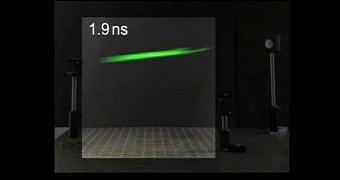Fog and other type of gas may render a laser beam visible to the human eye, but real, proper lasers are more or less invisible to our normal eyesight, especially when they are sent out in very short bursts.
You know the laser guns in Star Wars? Yes, those blaster bolts should actually move so quickly that we would not be able to perceive the light. If sound is faster than the eye can see, light/lasers are in a league of their own. “Plasma beam” technology explanations aside.
Laser is, in the end, nothing but tightly focused light. This, by extension, means that we need some really serious hardware to actually capture it in motion.
As it happens, a team of physicists at Heriot-Watt University in Edinburgh, UK, have managed to do just that.
A laser burst was filmed in nanosecond scale
We can only see the “laser” by sending it through a mass of smoke or water vapor, since that way some photons split off from the focused beam and head to your eyes.
This principle is the basis of a system devised by PhD student Genevieve Gariepy and her colleagues. However, they used normal air for it, as well as a camera system that records at 20 million frames per second.
The camera system used a 32×32 pixel grid of single-photon avalanche diode (SPAD) detectors. Each of those CMOS sensors have a high temporal resolution, meaning that data acquired by them can be correlated with real life fairly accurately.
In this case, the SPAD camera system has a temporal resolution of 67 picoseconds (0.000000000067 seconds), hence the 20 million FPS recording speed.
It can still only capture a few of the scattered photons at one time, but divide and conquer has an opposite we suppose. By shooting 2 million pulses over a period of 10 minutes, the research team had enough instances to combine into one, single video. We embedded the resulting mish-mash below.
Being connected to the laser emitter allowed the camera to know exactly when the pulse was produced, and react accordingly.
Practical applications
Creating cool videos is one thing, obviously. Observing the formation of plasma is another, as this SPAD system can allow one to see how ions are heated. However, those are distant concerns. The camera system is just a pure research experiment for now, intended to allow for a laser to be visualized in flight without direct interaction.

 14 DAY TRIAL //
14 DAY TRIAL // 